I finally got my printer working again. I spent the whole day going through Teaching Tech’s calibration steps. All the flat calibration gcode looks fine. The Benchies are another problem though. I’m printing with a 0.6mm nozzle for the first time.
On the smaller benchy I printed at 0.2 layer height, with a perimeter speed of 40mm/s at 210/60 temps. The bigger one is 110% larger and printed at 0.25 layer height, with a perimeter speed of 60mm/s at 215/60 C.
The problems are mostly manifested in the same area. Big blobs in the rear and layer shifting on the tail pipe. Large layer shifts/bulges in the center. I’ve never really ran into this problem before so I don’t know where to start when diagnosing this.
Check and make sure that your z screw is not sticking or binding. Also, make sure that the hotend is tightened and there are no gaps where filament can ooze from.
oh this is so weird. so very weird. look at this picture in particular. Look at the layers weaving up and down well before you get to the big ridges, when they still are… semi-normal. It’s not corner curl, it’s happening where the bottom is actually still flat. What the actual fuck.
Looking at that corner… it definitely just looks like corner curl. It can be incredibly hard to see when the printer is going, but unless your slicing software was telling the printer to raise the Y axis in the exact same pattern every layer, nothing can really cause that besides the corner of the print coming off the bed. You can fix that part by playing with the bed temp settings. Too low and the first lines won’t stick, or the print might pop off the bed of the nozzle runs through some hairy parts. Too high and you get prints like yours.
If you look at the sliced tool paths, what is it doing when it puts those Xs into your test print?
So, just to clarify, did you repeat the speed and temperature calibration with .6mm nozzle?
Remember you’re pushing almost twice the plastic out at any given time. (.4mm nozzles are .125mm^2 in cross section, .6mm nozzles are .282mm^2) 12v heater cartridges can frequently have a hard time keeping up. If this were happening, you might be able to see some oscillations in the hot end temperature as plastic is not getting hot enough (and starts clogging the printer, letting the heater catch up… causing the splooges.)
if you have octoprint, you can see the line chart of the temperature over time. Alternatively, pronterface will do the same when connected. (pronterface is somewhat easier if you have a computer you can bring near the printer. octopi’s are nice for the remote control, though.)
One solution in prusalicer is the max volumetric speed setting. What this will do is limit the maximum amount of plastic being pushed through to maintain a stable temperature. (once tuned, you can just leave it across nozzle and layer height settings. prusa will take care of the rest.)
I wrote a very long and detailed comment about your settings last night but it seems it didn’t save.
Long story short, your hot end has a maximum amount of filament it can melt and squeeze through your nozzle. Anything more than that and you’ll start to have issues.
Let’s say for example’s sake that your hot end cannot handle more than the default 0.4 nozzle 0.15 layer height @ 60mm/s. You can increase your nozzle size to 0.6, but you’ll need to decrease your print speed to keep the hot end happy. Even moreso of you increase layer height as well.
So in your post you went from 0.2 layer @ 40mm/s, to 0.25 layer @ 60mm/s. I don’t know what printer/ hot end you’ve got, but that’s kind of a lot of filament. You can increase print temp to compensate, which I see you’ve done, but remember that your filament has an optimal print temperature, and if you exceed that too far you’ll run in to issues there as well.
Have you already tried printing calibration towers (temp, speed, retract, flow etc)? If not, definitely look up a video or two on how to get them set up. They are much more effective for finding proper print settings than test prints like the benchy. Use towers to find the right settings, use your benchy to test the settings to make sure everything looks good.






